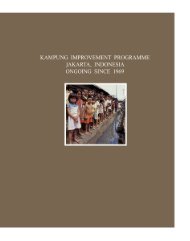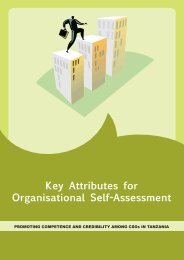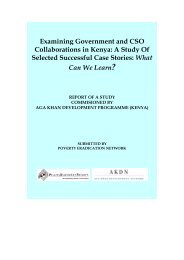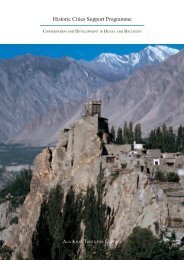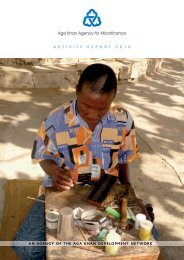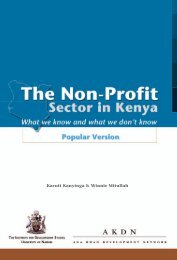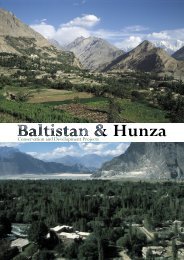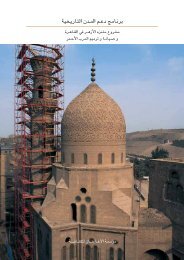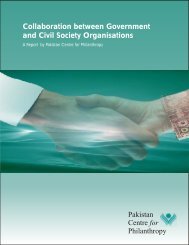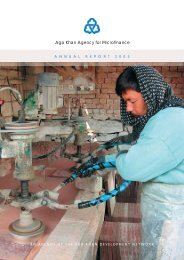WAKHAN & the AFGHAN PAMIR - Aga Khan Development Network
WAKHAN & the AFGHAN PAMIR - Aga Khan Development Network
WAKHAN & the AFGHAN PAMIR - Aga Khan Development Network
You also want an ePaper? Increase the reach of your titles
YUMPU automatically turns print PDFs into web optimized ePapers that Google loves.
THE PEOPLETHE WAKHIFor more than 2500 years <strong>the</strong> Wakhan Corridor has been<strong>the</strong> homeland of Wakhi people, who refer to <strong>the</strong>mselvesas Wakhik or Khik. Today about 10,000 Wakhi live inAfghanistan’s Wakhan District, with ano<strong>the</strong>r 40,000 living inadjacent areas of Tajikistan, Pakistan and China. Wakhi live inyear-round villages extending from Qazideh (2800m) at <strong>the</strong>western end of Lower Wakhan to Sarhad-e Broghil (3300m) at<strong>the</strong> eastern end of Upper Wakhan. Wakhi people are farmers,who cultivate wheat, barley, peas, potatoes and a few apricottrees at <strong>the</strong> upper limits of agriculture, where production israrely sufficient. Chinir, a festival celebrating <strong>the</strong> start of <strong>the</strong>barley harvest, occurs around <strong>the</strong> first week of August. Wakhidepend on livestock to supplement <strong>the</strong>ir agriculture, andalmost all households have some animals. Wealthier familieshave many sheep, goats and yaks along with a few camels,horses and donkeys. Every summer, Wakhi people take <strong>the</strong>irlivestock to summer pastures as high as 4500m, where <strong>the</strong>animals grow fat on abundant grass. Wakhi people speakWakhi, which <strong>the</strong>y call Khikwor. It belongs to <strong>the</strong> Pamir groupof Iranian languages and is spoken throughout Wakhan. Mostmen also speak Persian, which is used as a link language tocommunicate with people from o<strong>the</strong>r parts of Afghanistan.Wakhi people are Isma’ili Muslims, whose spiritual leader is<strong>the</strong> <strong>Aga</strong> <strong>Khan</strong>.Here could go a captionTrek to Tegermansu Valley.KUCHThe annual seasonal migration, or kuch, of Wakhi people and<strong>the</strong>ir livestock to and from summer pastures is a colorful sight.Yaks piled high with cauldrons, bedding and household goodsmove along <strong>the</strong> trail, while large mastiff-like dogs trot beside<strong>the</strong>m. Wakhi women, swa<strong>the</strong>d in red scarves and shawls, rideon yaks and camels with young children clinging behind <strong>the</strong>irmo<strong>the</strong>rs. Infants ride in cloth-draped cradles perched on <strong>the</strong>backs of yaks and <strong>the</strong> men walk alongside, leading <strong>the</strong> yaks, orride on horses.The spring migration usually departs from <strong>the</strong> villages in<strong>the</strong> first week of June. During <strong>the</strong> summer, <strong>the</strong> kuch movesprogressively upvalley to higher grazing areas, and in autumn<strong>the</strong>y retrace <strong>the</strong>ir routes downvalley. The joyous returnmigration arrives in <strong>the</strong> villages in <strong>the</strong> second or third weekof October. Travellers may encounter <strong>the</strong>se caravans in <strong>the</strong>Afghan Pamir, especially on trails leading to and from <strong>the</strong>Little Pamir.© 2004 John MockTHE KYRGYZCentral Asia’s Altai mountains along <strong>the</strong> western border ofMongolia are <strong>the</strong> traditional home of <strong>the</strong> Kyrgyz, a Turkicpastoral nomadic group. Each summer, small bands ofKyrgyz would migrate from lower valleys in Central Asia to<strong>the</strong> Afghan Pamir, but following <strong>the</strong> 1917 Soviet revolution,several thousand Kyrgyz settled permanently in <strong>the</strong> Big Pamirand Little Pamir. Their once wide-ranging migration becamea series of short, seasonal movements within <strong>the</strong> closedfrontiers of <strong>the</strong> high-altitude Afghan Pamir. Kyrgyz live in feltyurts or oey, which <strong>the</strong>y move seasonally according to availablepasture, sunlight and shelter from wind. Their settlements liebetween elevations of 4000m and 4500m. The Kyrgyz tendherds of fat-tailed sheep, goats, yaks and Bactrian camels,and trade with Wakhi neighbors or travelling merchants forall <strong>the</strong>ir needs not supplied by <strong>the</strong>ir livestock. Following <strong>the</strong>Soviet-backed 1978 coup in Afghanistan, some 1300 Kyrgyz,led by Haji Rahman Qul, left <strong>the</strong> Afghan Pamir for Pakistan.In 1982 this group of Kyrgyz was resettled in <strong>the</strong> mountainsof eastern Turkey. Today, about 1400 Kyrgyz remain in <strong>the</strong>Afghan Pamir. Their language is also called Kyrgyz, which isfrom <strong>the</strong> Kipchak group of northwestern Turkic languages.Most Kyrgyz men also speak Wakhi. Like all Turkic people,Kyrgyz are Sunni Muslims.www.wakhan.org8“It was a delightfully cosy yurt, carpetedwith bright felt rugs. Plenty of embroideredcushions and o<strong>the</strong>r fineries attested <strong>the</strong>owner’s wealth and comfort.”Sir Aurel Stein




